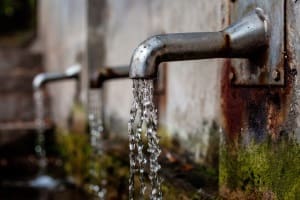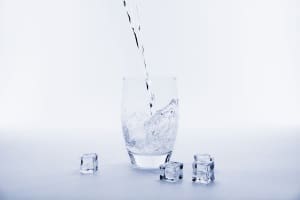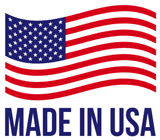Water Filters History
Thanks to the discovery and development of water treatment, we can all enjoy fresh, clean, and contaminant-free drinking water today. Did you know that the process of water treatment dates back all the way to 2000 BC?
The discovery of the purification of water and the development of water treatment methods from the earliest civilizations shows the importance of public health throughout the ages. Written in burial tombs and writings, our ancestors recommended water treatment methods to protect the public from microorganisms, chemicals, and disinfection byproducts in water supplies. Let’s walk through the history of water filtration below.
Ancient Water Treatment Methods
Water treatment methodology in ancient times was recorded in ancient Greek and Sanskrit writings. As early as 2000 BC, people knew and understood the importance of water purification through the process of heating water by boiling or heating under the sun. They also know how water filtration works using sand and gravel filtration and straining. These water treatment methods were recommended to improve public health since people do not yet know the difference between contaminated and clean drinking water during ancient times.
In fact, people were more focused on the taste of water rather than on its quality. Back in 2000 BC, turbidity was used to measure the quality of water. Therefore, contaminants such as potentially harmful microorganisms and chemical compounds were able to infiltrate and pollute water systems without being noticed. As a result, many people died from unidentified causes that can be easily pointed to water contamination today.
The Discovery of Coagulation
Post-1500 BC, the process of coagulation-flocculation was discovered by the Egyptians. The use of the water treatment technique by the ancient Egyptians were well documented in the walls of the tombs of the great pharaohs of Egypt. Illustrations of the purification technique can be found in both King Amenophis II and King Ramses’ tombs. The ancient Egyptians believe in the importance of purifying drinking water before consuming it. However, coagulation alone is not enough to produce clean and safe drinking water for human consumption.
Water treatment using coagulation allows the removal of SS and colloidal particles in drinking water. Impurities such as solids suspended in water and other small particles are removed using the chemical water treatment technique.
The addition of the chemical alum produces positive charges and neutralizes the negative charges on the particles present in the water. Alum is quickly dissolved and distributed throughout the water. Through this water treatment methodology, smaller particles stick together to form larger particles which allow for easier removal.
In the end, despite this improvement in removing visible impurities, people still do not realize the difference between clear water and safe water.
Hippocratic Sleeve and the Power of Sieving Water

The Hippocratic sleeve was one of the many contributions of the ancient Greek physician and father of Western medicine, Hippocrates. In addition to his idea of cleanliness, the discovery of the power of sieving water to produce clean and clear water was one of his significant contributions after 500 BC.
Through his experiments on water purification, he was able to develop a mechanical filter capable of catching impurities on the water. He called the crude water filter, Hippocrates’ sleeve. Water is passed through the cloth bag after being boiled to sieve particles before being used on his patients for healing. The first cloth bag filter was used to trap sediments to remove impurities and improve the taste of drinking water. The sleeve was a piece of cloth folded at the corners. Hippocrates used the sleeve to filter drinking water as a way to harness the healing powers of water. Although it will look crude compared to our modern water filtration systems, its contributions to early civilizations were significant.
The Roman Aqueducts
Roman engineers designed one of the most advanced water system technologies in ancient times in 300-200 BC. The method of transporting water from one place to another was first used and practiced by the Assyrians during the 7th century BC. They successfully carried water by harnessing the power of gravity throughout the 10 meters high and 300 meters long structures. The Romans built many of these structures back in Rome and called them “aqueducts” which in Latin means “water” for aqua and “to lead” for ducere. These sophisticated pieces of Roman engineering were used to supply water throughout the cities of the Roman Empire.
Without these structures, it is impossible to transfer the huge body of water throughout the cities of the empire. Since public health was one of the critical concerns of the leaders in Ancient Rome, these mega structures were believed to be designed to protect water from harboring potential pollutants. Aqueducts were built underground to keep impurities and chemicals from contaminating the water system. The Romans enjoyed the benefits of the water system and allowed the empire to flourish for years.
Archimedes’ Screw: The First Water Pump
During this time, the Greek mathematician, physicist, inventor, engineer, and astronomer, Archimedes of Syracuse, invented the Archimedes’ screw which allowed water to be pumped from one place to another. The device is made up of a screw housed inside a hollow pipe. The screw is powered by different sources of energy including manual labor, a cattle, or a windmill. It was formerly used to remove water from mines and from ship bilges.
Later on, the device was successfully used in sewage treatment in the past. It was the protocol for many modern-day pumps used in the carrying water from lower bodies of water to higher grounds. Today, a motor is used to turn the screw to transfer water from one point to another.
Water Filtration Techniques During the Dark Ages
The dark ages were also the darkest times in water filtration history since there were no upgrades or new discoveries to produce clean water for public use. After the fall of the Roman Empire, the greatest empire of the time, the sophisticated water system known as the aqueducts were destroyed along with the other stunning architecture of Rome.
During these times, there were no significant discoveries and development in water treatment technology. The lack of scientific experiments and innovations contributed to the dormant development of water filtration. Water distribution in Ancient Rome also became a problem due to the destruction of the aqueducts.
Water contamination became a prevalent issue during the dark ages. Many people suffered and died because of waterborne diseases. Since there was no way to observe contaminated water, people had no idea as to what struck them and what caused local epidemics.
The Discovery of the Process of Seawater Desalination

In 1627, Sir Francis Bacon started his experiment with seawater desalination and paved the way to the continuation of the re-advancement of water treatment methods. Since 71% of our planet’s surface is covered in seawater, the process of seawater desalination is a potential solution to humanity’s water scarcity problems.
The process separates dissolved salts and other minerals from water sources such as seawater, brackish, wastewater, wells, industrial feed, and process waters. His attempt to remove salt particles from water through the use of sand filtration technique allowed and encouraged other scientists and inventors to pursue the water filtration experiment and innovation.
Although his attempt at removing salt particles from water did not work out as planned, it gave others the idea to develop a process to remove salt particles and other minerals from different water sources.
Sir Francis Bacon’s contribution to modern water treatment is equally significant with the others despite its failure during his time. Seawater desalination today is significant since we are at a time where water is scarce in some parts of the world.
The Discovery of the Microscope and the Relevance of Safe Water
The microscope is one of the most important inventions of all time since it allowed people to study both good and bad microorganisms. The device was discovered by Antonie van Leeuwenhoek in the 1670s. His idea was taken from the experimentations of two Dutch spectacle makers who ground and polished lenses to experiment with object magnification.
The invention of the microscope allowed Antonie van Leeuwenhoek and other scientists to study and observe microorganisms found in the water. The connection between microbes and disease was now realized by experts in the fields of medicine and science and technology.
Due to this advancement in science and technology, people are now aware of microscopic life. There was now a realization that clean-looking water is not enough to promote and maintain good public health. Additionally, crystal clear water does not necessarily mean safe water for drinking, cooking, and bathing.
An Introduction to the First Water Filters
The first-ever water filters to separate suspended impurities and microbes from good water was built in the 1700s. Since man now understands the importance of removing contaminants like microorganisms along with suspended particles, water filtration systems for domestic application were designed to protect public health.
The first water filters were made of wool, sponge, and charcoal. Later on, these crude yet effective water treatment systems were developed and upgraded for municipal water treatment by Robert Thom in Scotland.
In 1804, he designed water treatment systems based on slow sand filtration. The water was distributed using a horse and cart. Since public health was important, the idea of giving every person access to clean, bright, and safe water began to materialize after three years.
The installation of the first water pipes began three years after Robert Thom’s invention of the municipal water treatment. Clean and safe water was delivered to every household in Scotland. Unfortunately, the practice of keeping filtered water was not yet practiced in other countries around the world. However, it was the start of a new era as it encouraged countries to pursue pure water.
The Discovery of the Disease Cholera and Its Early Treatment

Since the discovery of the microscope, scientists and medical experts were able to observe small aquatic living organisms. Some health risks were associated with the presence of microbes in drinking water. In the mid-18th century, cholera, an infectious disease responsible for severe dehydration due to watery diarrhea was spread by contaminated waters in London.
British scientist John Snow observed the epidemic and conducted studies on water contamination. Since he does not believe in the then-dominant miasma theory, he proved that cholera was spread through the water supply. In his 1855 essay On the Mode of Communication of Cholera, Snow pointed out the role of contaminated water supply in the distribution and eventual cholera epidemic in Soho.
Despite not being able to trace the cause of the disease, Snow was able to curb the local outbreak just by knowing the role of the water systems in the spread of the infectious disease. The mere removing of the handle of the water pump allowed Snow to put an end to the local epidemic. Reports on the cholera-like illness can be traced back to as early as 1000 BC in India.
Due to the increase in trade between nations throughout the ages, the deadly disease began to spread. The condition first reached London, then Newcastle, and the rest of Europe. Different treatment methods were applied during the 1800s and 1900s to patients with cholera.
Bloodletting, the use of opium and strong herbs were some of the treatments used to treat cholera at that time. By the mid-1900s, cholera was found as the culprit and was proven to be spread through the water by contamination. Since then, the then-dominant miasma theory was no longer believed to be the basis in every disease.
Then in the late 1900s, Louis Pasteur came up with the germ theory of disease which states that microorganisms are responsible for the diseases. Since then, the scientific theory for many diseases was used by medical practitioners up to this day and age.
Sand Filtration: Rapid Sand Filters, Upward Flow Sand Filters, and Slow Sand Filtration Methods
Sand filters are essential steps in the production of high-quality drinking water without the addition of chemical aids. The water industry relies on three types of sand filters. Rapid (gravity) sand filters, upward flow sand filters, and slow sand filters are the three methods of natural water purification.
The use of fine sand as a filtration medium will help separate impurities such as small particles from good water. The use of a sand filter can be traced back to the ancient Egyptians who used clay pots to filter drinking water. In 1804, the first sand filters were used to purify the water supply in Paisley, Scotland.
By the late 1800s, America started its first sand filters as a means to protect its people from potential health diseases caused by water contamination. The sand filters the Americans have built were huge and designed using the rapid sand filtration method instead of the slow sand filtration technique. The American sand filtration system became a success in the United States and later on became a household necessity.
The use of a powerful jet stream to clean the filter system allowed the easy maintenance of larger filter capacity. Improvements to the water filtration system were later on added to provide a more efficient water treatment. Dr. Fuller incorporated the process of coagulation and sedimentation techniques to the already-successful sand filters.
Since the process of water chlorination was also being used at that time, the adding of the chemical aid on water significantly reduced the rate of waterborne diseases in the country. The likes of cholera and typhoid became less of a threat in America thanks to the continuous innovation of water filter systems. The quality of water in America became better due to the water treatment innovations in the country.
Chlorination and the Challenges with Its Use For Drinking Water

Despite the drastic drop in waterborne illnesses, public health was still unsafe with the use of chlorine in drinking water. It was not long before chlorination revealed its negative side effects. The victory brought by the adding of chlorine compound on water was somehow brief. Chlorine or chlorine compounds such as sodium hypochlorite added to the water will eventually vaporize and cause respiratory problems when inhaled by a person. Since it vaporizes quicker than water, it resulted in devastating health problems for the victim.
Water experts began to look for safer alternatives without compromising the quality of water. Calcium hypochlorite and ferric chloride were both added to drinking water in Belgium in 1902. Although they were seen as better alternatives to chlorine, water filter systems today are designed to remove chlorine from drinking water. The challenges with its use are still predominant to this modern age. Fortunately, we are well-equipped and informed on how to remove the chemical compounds from water sources.
By 1903, further innovations on water filtration brought over the technique of water softening for water desalination. Eleven years later, water standards for public water systems were implemented based on coliform growth. Unfortunately, the water standards were never implemented to each municipal water treatment plant until the 1940s.
Although people are well aware of the importance of clean and safe drinking water, it wasn’t until after thirty more years that everyone was entitled to a right to clean and safe water in America through the Safe Drinking Water Act.
Filtration of Pesticides and Disinfection of By-Products

Since 1970, water standards were no longer focused on cholera and other waterborne diseases. Instead, they’ve shifted their focus on anthropogenic water pollution. Also, aside from chlorination, there are other potential contaminants to water systems including pesticides and disinfection byproducts. Pesticides, chemicals, and byproducts pose a significant threat to public health. These human-made pollutants pressured the government to create new regulations to address the water contamination issues. Pesticides in agricultural settings runoff or leach into private wells and nearby water systems. As a result, public health suffers anew due to improper use, disposal, and storage of insecticide.
Since water standards are now directed at industrial wastes and industrial water contamination, water filtration systems are designed to remove contaminants to below the acceptable standards. Water treatment innovations including aeration, flocculation, and granular activated carbon (GAC) were applied to modern-day water filter systems.
Membrane development or the use of a semipermeable membrane in Reverse Osmosis or RO was developed in the 1980s. Two years later, the regular running of risks assessments of the water was enabled.
Water Filters of Today
Water treatment experimentation and innovations, such as whole house water filters, today are mostly inclined on disinfection byproducts such as trihalomethane (THM) formation. Lead and other heavy metals are also strictly monitored in public water systems due to their potential health threats.
Today, the government is doing its best to protect the public from chemical contaminants, microorganisms, and whatever is associated with health risks in drinking water. The original pipelines were also replaced with more health-friendly materials to reduce health threats.
Sources:
https://scholars.unh.edu/cgi/viewcontent.cgi?article=2361&context=dissertation
http://citeseerx.ist.psu.edu/viewdoc/download?doi=10.1.1.909.2953&rep=rep1&type=pdf







